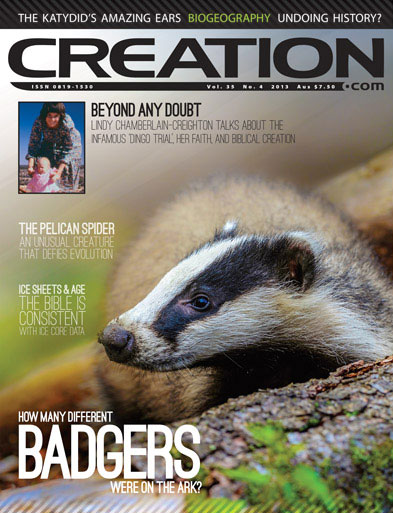Katydid’s amazing ear design

Our sense of hearing requires exquisite design features. As you probably know, it’s hard to hear someone talking to you if you’re under water and they are above, or if you are above the surface trying to hear underwater sound. That’s because most sound energy is reflected at the air-water boundary rather than being transferred through. But our hearing requires this very same transfer of sound energy from air to liquid, since our sensory cells are immersed in liquid—to avoid drying out. And the sound waves are very low energy to start with.1
Our ears solve this problem, called acoustic impedance mismatch, with the tiniest bones in our body: the three inner ear bones act as impedance converters. The eardrum collects the air vibrations of sound, and these cause the ear bones to vibrate. These bones act as levers to increase the force of vibrations applied to a window in the coiled liquid-filled cochlea. This is a frequency analyzer, lined with sensitive tiny hairs that pick up different frequencies and cause nerve impulses. Our brain interprets them as sounds of different pitches.

Scientists at the University of Bristol (UK) have found that an insect uses the same principles on a far smaller scale.2 The orange-faced South American katydid Copiphora gorgonensis sings at 23 kHz (23,000 cycles per second), too high for humans to hear, but this is designed to attract a mate. So they must also be able to hear at this ultrasound frequency. Indeed, they hear from about 10–50 kHz, so they can probably tell the difference between a mate and a bat hunting with its amazing echolocation capabilities.3
Katydid ears are only 600 microns (1/40 inch) long,4 smaller than a rice grain. And they are on the legs, not the head. The new discovery is a tiny and easily overlooked tube, filled with oil under pressure—it bursts when opened. So the researchers used microscopic CAT scans to analyze it. The katydid has an eardrum connected by a lever to a plate inside the tube, and the air side of the lever is longer than the liquid side. So any sound vibrations in the air generate smaller movements but with greater force in the liquid in the tube, where sensor cells detect them. This is a very efficient system, simpler and more robust than ours, and on a much smaller scale.
However, the researchers paid the obligatory fact-free homage to evolution. They proclaimed that the human and katydid ears are a great example of convergent evolution. That is, supposedly unrelated structures evolved to perform the same function. But the evidence fits better with a Designer solving the same acoustic problems using the same principles applied in remarkably different ways. Indeed, lead researcher Dr Fernando Montealegre Zapata says that the “efficiency of this tiny system could inspire engineers to create microsensors based on the katydid’s ear design.”4 Ron Hoy, a professor of neurobiology and behaviour at Cornell University, wonders what katydid-inspired sensors “could be in the hands of an imaginative engineer?”5
References and notes
- We can measure the strength of sound by the difference in pressure from the normal. One atmosphere of pressure is 101,325 pascals. But we can hear sounds (at 1 kHz) with a pressure difference of only 2×10−5 Pa. Return to text.
- Montealegre-Z., F., and four others, Convergent evolution between insect and mammalian audition, Science 338(6109): 968–971, 16 November 2012 | doi:10.1126/science.1225271. Return to text.
- Underwood, E., Rainforest insects hear like humans, news.sciencemag.org, 15 November 2012. Return to text.
- Fesssenden, M., Bug-Eared: Human and insect ears share similar structures, scientificamerican.com, 19 November 2012. Return to text.
- Hoy, R.R., Science 338(6109):894–895, 16 November 2012 | doi:10.1126/science.1231169 (comment on Montealegre-Z., Ref. 2). Return to text.



Readers’ comments
Comments are automatically closed 14 days after publication.